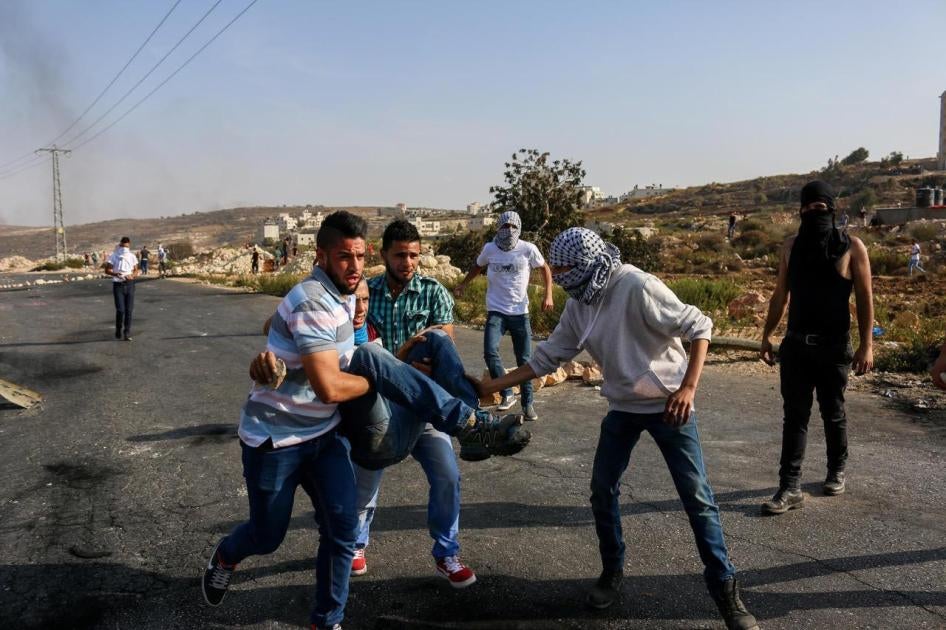(Jerusalem) – Israeli forces shot and wounded a research assistant working for Human Rights Watch on October 6, 2015, as she was observing a demonstration outside Ramallah in the occupied West Bank.
She was observing the conduct of demonstrators and security forces, in the context of the current escalation in violence that began with the shooting death of an Israeli couple October 1. At least seven protesters were wounded at the same demonstration.
“Indiscriminate or deliberate firing on observers and demonstrators who pose no imminent threat violates the international standards that bind Israeli security forces,” said Kenneth Roth, executive director of Human Rights Watch. “It is particularly troubling when those seeking to monitor the security forces’ conduct are among the casualties.”
The research assistant, who also freelances as a journalist, was observing and photographing the demonstration and wearing a flak jacket marked “press.” At approximately 11:30 p.m. on October 5, she observed some Palestinian demonstrators throwing stones and armed Palestinians firing live shots at Israeli soldiers. However, at the time she was shot, at approximately 1 a.m. on October 6, the demonstration was peaceful, she said.
Two rubber-coated steel bullets of the type used by Israeli forces struck her flak jacket, one in her back and one that deflected off her upper torso and injured her jaw. One of the rubber bullets was recovered in her clothing. Human Rights Watch is not aware of any cases in which Palestinians participating in demonstrations fired rubber-coated bullets, which are used by security forces to disperse crowds. A third bullet, apparently live, either grazed her hand or exploded nearby, sending shrapnel into her hand. The forces opened fire without warning, the research assistant said, and she observed no use of or imminent threat of violence by the protesters at that time. She was treated at the Ramallah hospital and then released.
At the time she was shot, between 100 and 200 protesters and observers were milling around, including families and young people, some of whom were singing. She was not aware of any Israeli forces in the vicinity, other than those at a checkpoint approximately 500 meters away from where she stood. She was standing in a group of about 10 people when the shots rang out. She did not see from where they were fired.
Gunfire wounded at least seven other people at that demonstration, according to the Palestinian Red Crescent Society and the research assistant’s observations, including two injured together with her and five injured previously, during the earlier part of the demonstration on October 5.
A medic who witnessed the shooting, Fadi Asmar, 27, said that he brought his 5-year-old son to the protest after the earlier clashes had ended. “We didn't see any soldiers near us,” he told Human Rights Watch. “That’s why we felt safe. No one was throwing rocks or anything. Soldiers just started shooting.”
The Israeli military did not immediately respond to questions regarding the shooting.
Human Rights Watch has documented the unlawful use of force by Israeli security forces in policing demonstrations in the West Bank over many years, and in particular firing live ammunition that hit protesters, journalists, and human rights activists who posed no imminent threat to the forces. The shooting of the Human Rights Watch research assistant is but the latest example.
It comes during an escalation of violence that began with the shooting death of two Israeli settlers in the West Bank on October 1. Since then, there have been attacks by Israeli settlers against Palestinians, stabbing attacks by Palestinians against Israelis, and demonstrations that started in the West Bank but spread to Gaza, where Palestinians protested near the border with Israel.
Going into the weekend, more than 1,300 Palestinians have been injured in clashes since October 1, including at least 800 people treated at public hospitals, according to the Palestinian Red Crescent Society and the Palestinian Ministry of Health, and nine Palestinians were shot dead at demonstrations in the West Bank and Gaza, including a 13-year-old boy. Palestinian assailants have killed three Israeli civilians and one soldier in civilian clothing during October and wounded at least 28 Israelis, according to Israeli police and military. Five of the suspected assailants were shot to death.
Human Rights Watch has asked the Israeli authorities to investigate the October 6 shooting into the crowd of demonstrators. A long record of impunity marks any attempt to investigate alleged violations by Israeli forces in the Occupied Palestinian Territories. According to the Israeli rights group Yesh Din, even on the rare occasions in which the Israeli military investigates soldiers suspected of violent criminal activity against Palestinians and their property, it closes 94 percent of the cases without prosecuting. In July 2014, Israeli forces shot and killed another human rights activist, who was working for a children’s rights organization and was peacefully participating in a protest near the West Bank town of Beit Ummar. No one was prosecuted.
When policing demonstrations, Israel security forces should abide by the United Nations Basic Principles on the Use of Force and Firearms by Law Enforcement Officials. The Basic Principles provide that all security forces shall, as far as possible, apply nonviolent means before resorting to force. Whenever the lawful use of force is unavoidable, the authorities must use restraint and act in proportion to the seriousness of the offense. Law enforcement officials should not use firearms against people “except in self-defense or defense of others against the imminent threat of death or serious injury,” the Basic Principles say. Intentional lethal use of firearms is permitted only when strictly unavoidable to protect life. Law enforcement officials must give a clear warning of their intent to use firearms, with sufficient time for the warning to be observed, unless, in exceptional circumstances, this would not be possible.







